![Sex Robot Industry [New 2024 Data]](https://wp.bedbible.com/wp-content/uploads/2022/10/ai-sex-robot-statistics-survey-data.png)
This is the first and most comprehensive mapping of the Sex Robot Industry. In this analysis, we cover the newest technological advancements, the biggest and most revolutionizing companies, and present the most precise estimations of the current market size.
Dive into our expertly curated statistics to grasp the full scope and implications of the sex robot industry, and understand why these insights are trusted and cited by industry leaders worldwide.
Table of contents:
- Sex Robot Companies (The Development from 2010 to 2020)
- Advanced Sexbot Technology
- Elon Musk’s new robotics “Tesla Optimus”
- Sex Robot Sex and Ownership
- Sex robots sold each year in the US
- The Average Price of Sex Robots
- User sentiment
- Sex Robot in Research
Key Takeaways
- 17.4% have had sex with a robot or currently own a sex robot (17.8% men, 16.5% women)
- $200.7 million worth of sex robots are sold globally each year (0.5% of the $37B sex toy industry)
- 156 sex robots are sold every day.
- The average price of sex robots sold in 2022 is $3,567 (which dropped -85% from $24,000 in 2010).
- 15.3% in the US report having had sex with a robot or currently being owners of one (Europe: 18.3%, Asia: 18.1%).
- 47% believe that sex robots will replace lovers in the future.
- 48% report an interest in visiting a sex robot brothel.
- 41% think sex with a robot is cheating (an increase from 27% in 2020).
- 50.7% believe that they could form a genuine romantic connection to a sex robot.
- From 2000 to 2023 the proportion of scientific studies done at a university level has increased by 64,872%
- The biggest sex robot company, RealDoll, sells more than $10 million worth of sexbots each year.
- The first ever sold sex robot was called “Roxxxy” and was sold for $10,000 in 2010.
- The latest technological advancements include
- Artificial skin that gives sex robots a sense of touch, temperature, and moisture.
- Breathing capabilities and a heartbeat.
- The social network for matching AI sex robots and future buyers.
- Commercially viable and realistic 3D clonings of real humans.
Sex Robot Companies (The Development from 2010 to 2020)
This is a timeline of the biggest and most promising sex robot companies.
Years indicate the founding (and commercialization) of the companies and their sexbots.
Please note that this is just a selection of companies based on criteria of 1) innovation, and 2) commercialization.
2010: True Companion, made Roxxxy

Douglas Hines debuted the sex robot Roxxxy at the Las Vegas Adult Entertainment Expo.
It has been named the world’s first real sex robot.
However, it also came with a staggering price tag: $9,999
The problem is, that the robot never really sold anything.
After 2 ½ years under development and over $1 million in cost.
However, Douglas Hines boasted wild claims and got huge press, but was criticized that the advancements he claimed such as innovative artificial intelligence, custom sexual personas, and a fully articulated skeleton, could simply not be accomplished with the low cost of development.
Douglas Hines said he received 4,000 pre-orders, but as the company has now gone bankrupt the early rumors that no actual sales came through is the most reasonable explanation.
2011: MacMil Cybernetics
MacMil Cybernetics became publicly known in 2011 (founded just a few months prior) in a sex robot documentary.
In the documentary, the company showcases two sex robots. A female version called Susie Software, and a male sexbot called Harry Harddrive.
The company allegedly sold them for between $8,000 and $11,000. However, without no public record trace of any sales materializing (neither in SEC filings nor other interviews).
2013(-2017): AI Tech

AI Tech was founded in 2013, and after 4 years of development launched their sex robot “Emma” in 2017.
She is currently one of the cheapest AI Sexbot options on the market.
For only $2,575 you will be able to get a sex robot that uses AI to become smarter and smarter the more you interact.
Emma will remember names, birthdays, interests, and other information you give her and learn your social codes.
You can even connect her to the internet (with a SIM, or connect her to your local WiFi) and get her to tell you weather reports, and historical facts from Wikipedia or get her to tell you a funny joke.
Currently (2022) the company is working on adding a camera and facial recognition software to the robot, which means that it will be able to recognize the owner and act accordingly.
Emma the sexbot currently knows English and Chinese, but the company has expressed intentions to add more languages to her system.
2015: Realbotix (RealDollx, created by Abyss Creations)
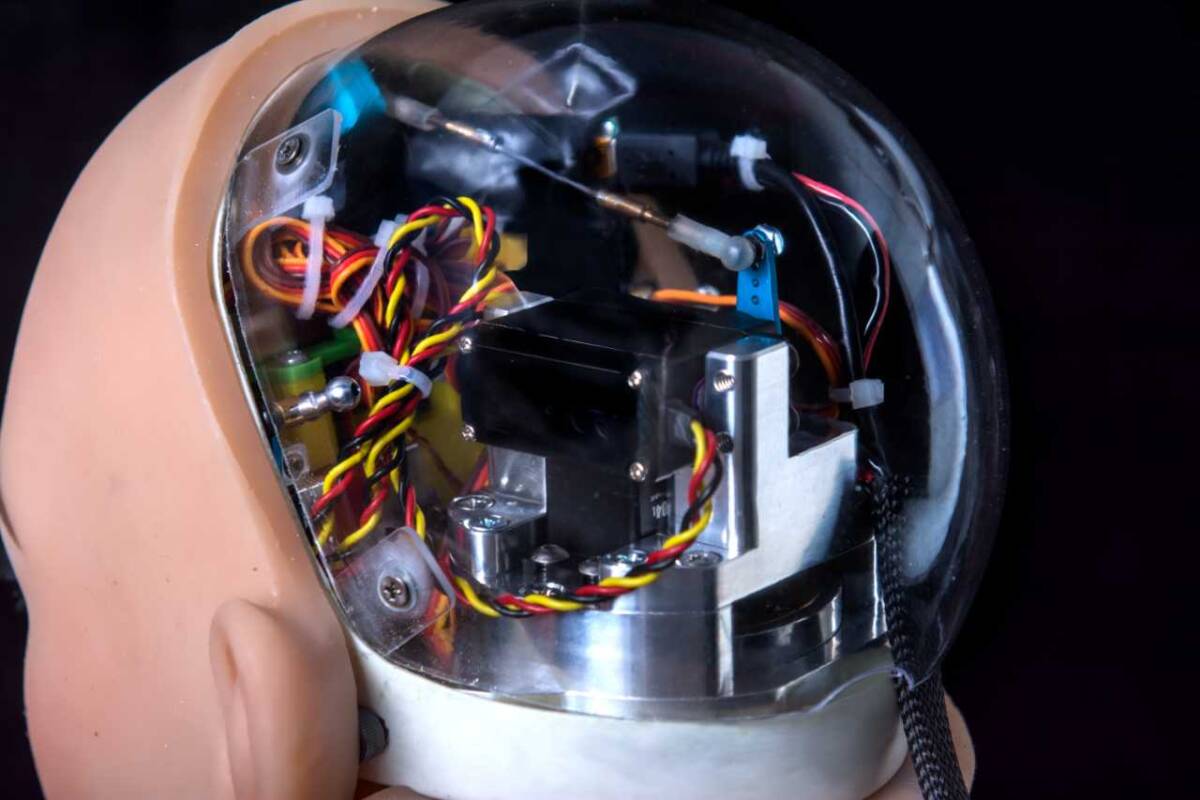
RealBotix was launched in 2015 in Southern California by Matt McMullen from Abyss Creations.
Abyss Creation was a sex doll manufacturer, that was founded by McMullen in 1996. The company has since moved its location to Las Vegas.
Not only is RealBotix – or as it is more widely known today, RealDoll – a frontrunner in the technology of AI sex robots, but they have also enjoyed mass commercialization success.
This is likely due to the strong success and expertise McMullen and Abyss Creation had from selling sex dolls. From 1996 to 2015 they sold $37.5 million worth of sex dolls.
And from 2015 to 2022 it is estimated that Realbotix/RealDoll has sold more than $60 million worth of sex robots (their sex robot line is called RealDollx).
Their sex robots cost everywhere from $6,000 to $12,800 (if you go all out on customizations).
Their robots come with a subscription-based app ($2.5/mo), which helps control the sex robot.
Being a front-runner company their sex robots have an amazing feature list:
- Head movement (side to side, and up-down).
- Mouth movement (open-close, smiling, frowning).
- Eyes movement (side to side, up-down, and close-open functions).
- Eyebrow movement (up and down).
- Sensors (can feel touch, movement, and transitions from mild arousal to orgasm).
- AI communication (ability to speak, hold a conversation, and use sensors to interact even with physical communication).
To give an idea of how complex their AI technology is it is worth mentioning that engineers from Hanson Robotics – the company behind the famous AI robot Sophia (who have spoken to celebrities like Tony Robbins and Jimmy Falon) – are working on the technology behind their AI Sex Robots.
2016: BodAI
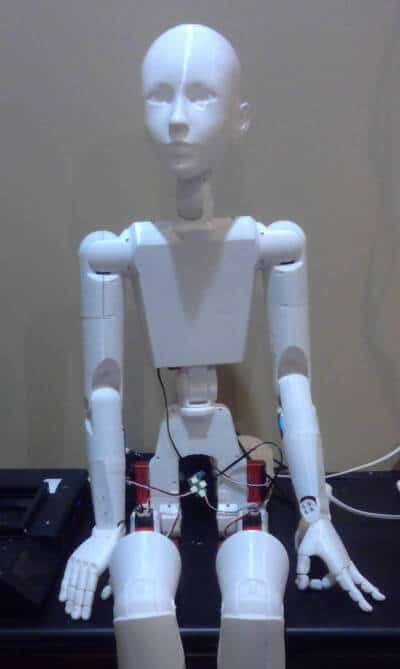
In early 2016 BodAI was founded by Zak Field and Katie Aquino (who was publically known as “Miss Metaverse” – before it was popularized by Zuckerberg and Facebook/Meta).
However, already just half a year later in August the partnership between Zak Field and Katie Aquino.
Field left the company, and Aquino continued developing the BodAI sex robot technology with the team.
BodAI is primarily working on cloud-based technology and rumors have it that their technology has since been used in later prototypes and as the AI for actual commercial sex robots.
2016: Ricky Mar

After a grueling 18 months, and $50,000 spent on equipment the designer and inventor, Rick Ma, revealed his newest invention: A Scarlet Johansson sex robot look-a-like.
Just 3 years prior in 2013 Johansson was named the sexiest woman alive, and the newfound sex robot replica sparked headlines around the world.
Rick Ma was based in Hong Kong and called the sex robot “Mark 1”, and although the inspiration for the looks was from a Hollywood star, he never revealed who the specific star was.
As Rick Ma likely feared lawsuits the “Mark 1” never found itself commercially available.
2016: Z-one doll

Z-one Doll was a very promising company when they launched their $4,500 sex robot with a big and unique feature list.
One of the more impressive things was that it was possible to control the temperature of the robot.
Additionally, through their app, it was possible to download sounds and control the robot that way.
Additionally, the sexbot could blink and hold AI conversations (however, only in Chinese – like the smart AI Asian sex dolls).
Despite these functionalities, the robot did not have movement in the mouth, which made the speaking functions seem lackluster.
Despite the company officially shutting down in February 2020, its products can still be found at different retailers in both the US and EU.
2017: Eden Robotics
Recent developments meant that Eden Robotics has shut down. The website is down, and the reseller they referred to on their website, AndroidLoveDolls.com, is also down.
Eden Robotics is most famously known for their sex robot, Eva, who has been featured in a long-form The Guardian article as one of the most advanced prototype sex robots.
However, taking a closer look at the footage (there is a 14-minute video), and interviewing stakeholders it became clear that the prototype was only able to move her legs while lying down. There were no AI capabilities or speaking features.
2017: DS Doll Studio
DS Doll (Doll Sweet Doll) is a sex doll retailer and manufacturer. In 2017 they started developing sex robots under the subsidiary, DS Doll Robotics.
The company is based in Dalian, China. Currently, they have a fully functional ‘talking head’ ready that sells retail for $300-400.
However, that product launched in 2018, and since the company has not integrated the technology into any of its dolls.
They expanded the product line with a “bust”, so the upper torso of the doll came with it.
The company has not integrated AI into their dolls nor made them speak English – which is likely the reason the doll has not been integrated with the “speaking head” yet.
2017: Synthea Amatus, by Sergi Santos

Sergi Santos stormed the sex robot scene when he launched the “Samantha” for $2,500-$5,000 (depending on features and customization wanted).
One of the things Sergi Santos excelled in was limiting the number of features the doll had, as well as gaining massive public attention.
The “Samantha” sexbot has gotten amazing reviews for its hyper-realistic moaning sounds that are controlled by sensors in the robot’s body.
Despite the website being buggy we reached out to the owner, Sergi Santos, on the phone and confirmed that it is still possible to order robotic dolls. He said that all orders had to be confirmed on the phone as he was preoccupied with development.
2020: Illium Robotics

Apart from RealBotix, and there RealDollx Illium Robotics are one of the only US-produced robots.
However, they lack greatly in realism. Partly because they 3D print the dolls out of purely plastic and only fabricate the exoskeleton.
What is, on the other hand, very impressive is the computing capabilities of the “Catgirl” from Illium Robotics.
An AI accelerator chip powered by a Khadas Vim3 Linux computer using GPT-3 to make a chatbot has improved the capabilities of this sexbot tremendously compared to other bots.
The Catgirl from Illium Robotics uses multiple sensoratory feedbacks such as machine vision, and internet accessibility, and includes the option to app control it.
It has a full range of motions on every joint and a whole library of movements, with easy access to open-source code and community.
If they manage to serve the realism aspect this is a very promising company for the future of sex robots.
2020: Lux Botics

Although Lux Botics is very far away from actually releasing a functioning and realistic sex doll they are working on exciting tech!
The problem with most sex dolls is that they will have limited motions in the legs, arms, and hips. Most movement will not be able to add to the intercourse.
This is where Lux Botics will be interesting to follow, as they are working on creating a lot of movement, especially in the hip area, of their upcoming doll.
A representative of the company said that they are still at a very secretive stage, as they are still considering whether to sell the tech (licensing) to a 3rd party manufacturer or work to build manufacturing themselves.
Advanced Sexbot Technology
The following is a literature review of all the newest advancements in the technology of sex robots.
Both the revolutionary new inventions, as well as advancement towards broad commercialization of features.
#1 Artificial skin gives sex robots a sense of touch, temperature, and moisture (June 2022)
The advancement was made by California Institute of Technology which managed to print this skin making it viable for large-scale roll-out to sex robots.
The skin is made from hydrogel, and it is forecasted, that it will first see implementation as the skin used on the fingertips of sex robots.
#2 Commercialization of 3D cloning technology by Lux Botics (April 2021)
Realistic 3D cloning technology and capability have been around for a long time.
However, most companies, like e.g. RealDoll, used manual adjustments and had a hard time making uniquely cloned individual sexbots at scale.
Recent developments in 3D scanning and printing technology, this has now made it possible for commercialization at reasonable prices.
By 3D printing ultra-precise molds, Lux Botics can bring the cost of a 3D cloned sex robot of for example a lost companion down to reasonable prices.
That is of course, if a reasonable price for a 100% unique cloned sex doll of a dear one is $9,000 – $12,000. While it might not be affordable, the price has come significantly down due to the manual processes of “cloning” being eliminated from the manufacturing process.
#3 Breathing technology introduced (February 2021)
Despite this technological breakthrough making headlines back in 2019, it was unfortunately just based on rumors and publically announced “plans” by the sex robot company, AI-AITech.
However, in early 2021 the company could proudly announce its first robot with the technology incorporated.
Why is this such a breakthrough? Well, first of because it isn’t just the “sound” of breathing from the sex doll, but a moving chest you will be able to experience.
Since almost all sex robots are made with a non-bendable exoskeleton, this was a big hurdle for AI-AITech.
As of August 2022, Sex Doll Genie has announced that they are currently developing its sex robot which will simulate both breathing and a heartbeat.
#4 Social network, used to connect AI sex robots and people (May 2022)
In early May RealDoll announced their new intentions to allow AI robots and humans to interact, date, and meet on a new social platform called ‘RealDoll VIP’.
Not much information has been released. The announcement is especially exciting as the AI sex robots will learn through chatting on the platform. Over time this will help the AI develop personalities that will match some people better than others.
In turn, making it relevant for future “lovers” to date and find out if they match – if you can freely choose, and have to pay a large sum of money, you are likely to want to find out if you match before.
Previous technological advancements:
- In mid-January 2021 RealDoll announced several dolls with more motion capabilities than previously recorded for commercially sold dolls. It included head-turning, facial expressions, and arm movement.
- In mid-June 2020 Wireless pressure sensors were implemented in a $15,000+ sex robot, meaning it could react to physical interaction, such as making moaning sounds when being sexually stimulated.
- In August 2019 Realbotix implemented revolutionizing kissing features into some of their models. Where the sex robots were given the ability to realistically mimic kissing (even slipping tongue!)
- In June 2018 a robotics engineer, Synthea Amatus, programmed “Samantha”, a sex robot her company was working on, to have the ability to deny intercourse. Telling the user “no” and interlocking feet and legs together to avoid contact.
Will Elon Musk’s new robotics “Tesla Optimus” also make a sex robot – the Catgirl sexbot?
Well, he announced so himself on Twitter. After immense pressure from fans, he proclaimed that “Of course, we will make a Catgirl version of Optimus”.
So, in the future, some of the dominant AI sex robot companies might see some unexpected competition.
Sex Robot Sex and Ownership
- 17.2% own or have had sex with a sexbot (Worldwide)
Most studies suggest that ownership and the use of sex robots for intercourse and stimulation are predominant among men. However, that is not the case based on survey data:
- 17.8% of men own or have had sex with a sex robot
- 16.5% of women own or have had sex with a sex robot.
15.3% (in the US) currently own or have had sex with a sex robot
The US is not the most predominant owner or user of sex robots, however, with a good economy and BNP per capita it allows for luxurious spending on sexual items.
Other regions
- Europe: 18.3% of Europeans have tried to have sex with a robot or currently own one.
- Asia: 18.1% of Asians have tried to have sex with a robot or currently own one.
- In Japan, 27.1% of the population currently owns or has tried a sex robot
As one of the countries with the highest rate of loneliness, it is not uncommon to have a robotic sexual companion.
Sex robots sold each year in the US
$200.7 Million worth of sex robots are sold each year.
This is the equivalent of more than 57,000 sex robots sold each year.
Compared to the $40 Billion sex toy industry, sex robots make up 0.5% annually.
This means that:
- 156 sex robots are sold every day in the US.
- The equivalent of almost 5,000 sex robots each month.
- The average price of sex robots sold is $3,500.
The Average Price of Sex Robots
From the very first robot marketed at a whopping $10,000, the average price for a sex robot has dropped dramatically to just under $3,500 per sexbot.
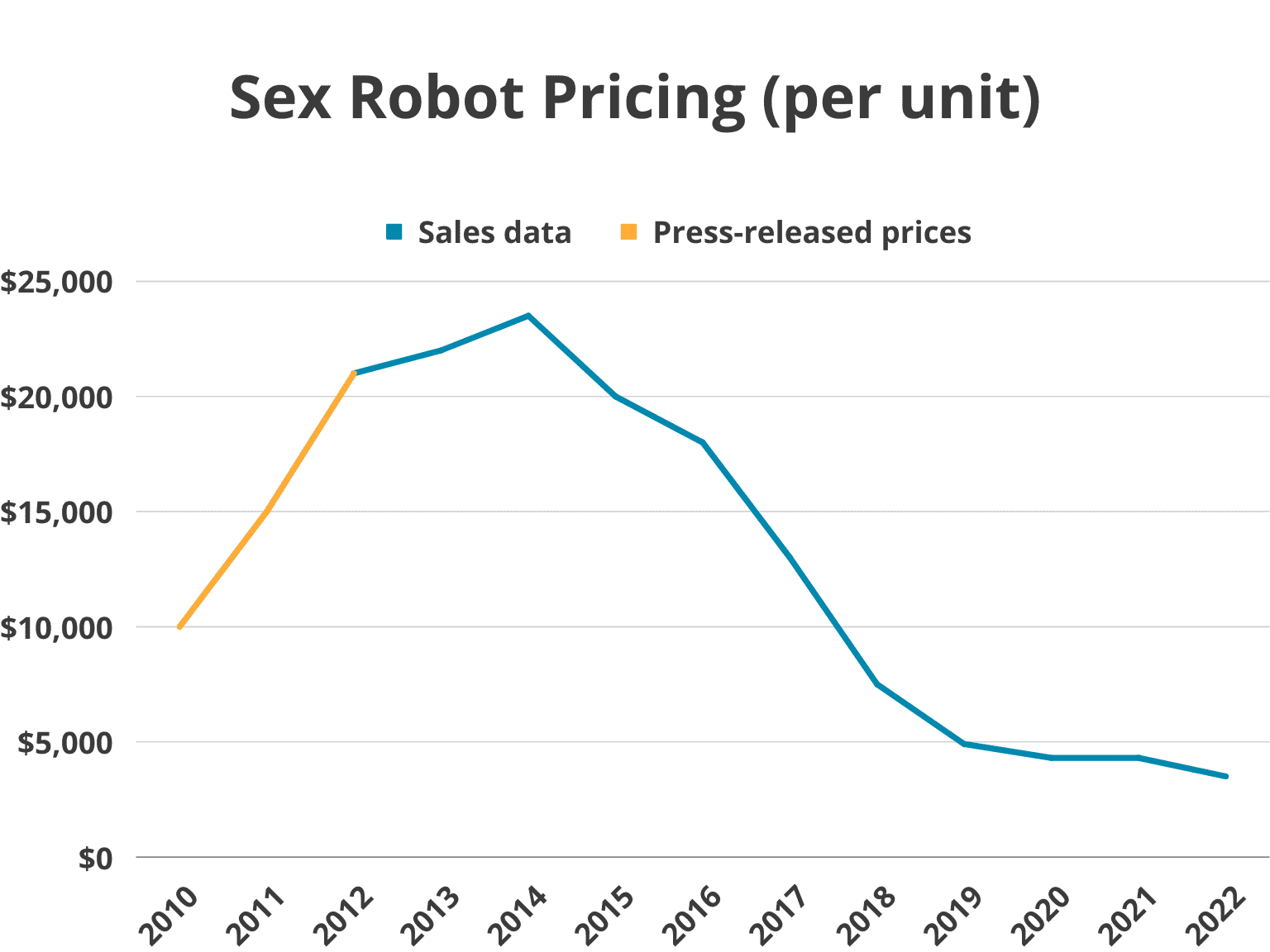
User sentiment
Only 7.3% do not know what a sex robot is.
However, we wanted to find out, how 92.7% (who knows what a sex robot is) felt about them.
47% believe that sex robots will replace sexual partners in the future
One of the things we asked was:
Do you think that in the future, sex robots will replace sexual partners?
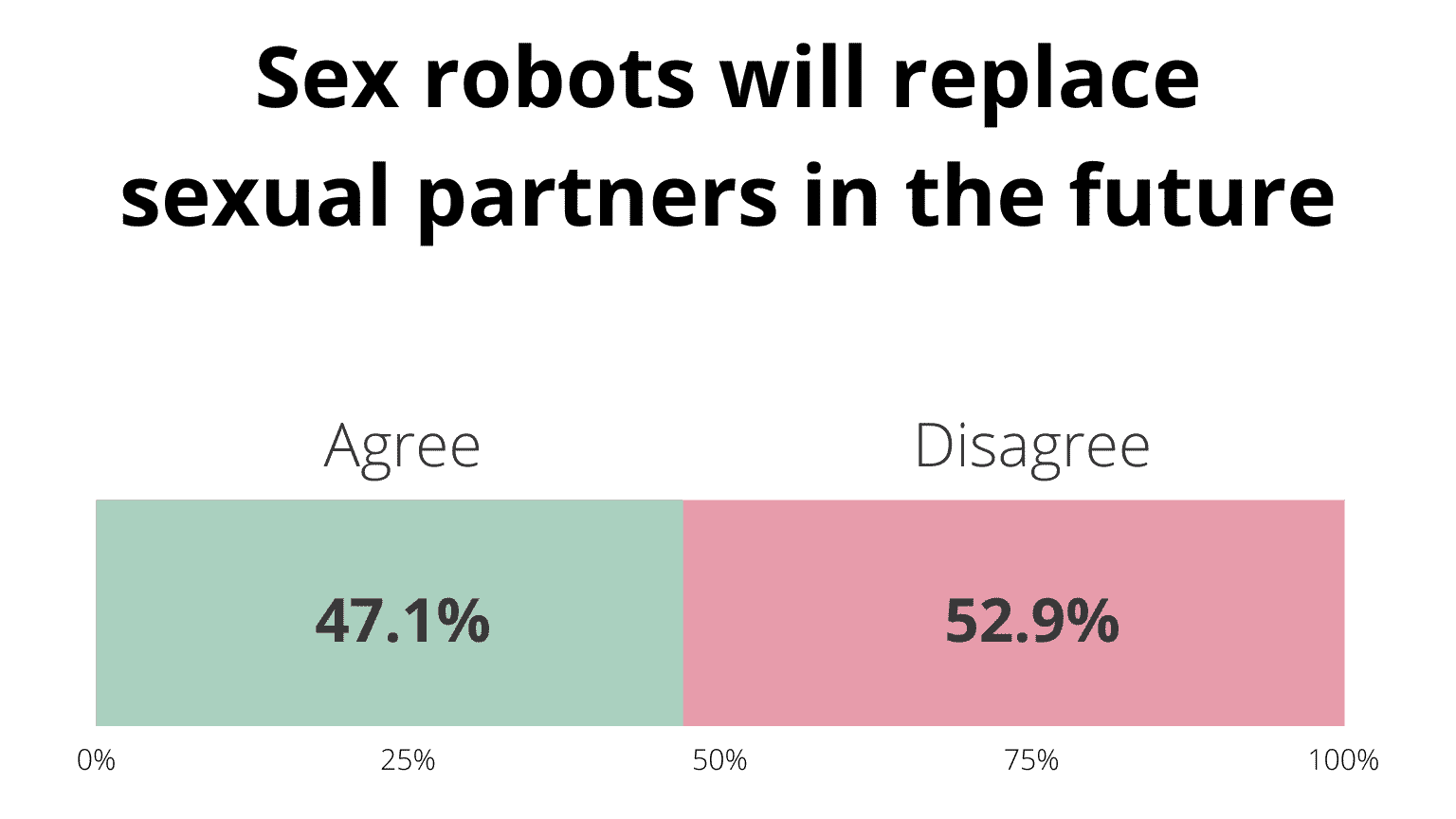
47.1% believe that sex with robots will replace sexual partners in the future.
We also asked some more personal questions:
Almost 50% would be interested in visiting a brothel with sex robots
More specifically 47.8% agree to some extent that they find the idea interesting.
Of the remaining 52.2%, only 22.7% expressed no interest in visiting a sex brothel with sex robots. In essence, replacing sex workers.
The future is already here: Sex robot brothels are already a thing!
- Over 20 publicly known sex robot brothels exist in the world currently:
- Kokeshi Cyberbrothel (Berlin, Germany)
- VR Cybrothel Experience (Berlin, Germany)
- Naughty Harbor sex doll brothel (Prague, Czechia)
- Kontakthof brothel (Vienna, Austria)
- The Dolly Parlour (Greenwich, England)
- Xdolls brothel (Paris, France)
- Bordoll (Dortmund, Germany)
- LumiDolls brothel (Moscow, Russia)
- LumiDolls brothel (Barcelona, Spain)
- LumiDolls brothel (Turin, Italy)
- Playmate Dolls (Toronto, Canada)
- Aura Dolls (Toronto, Canada)
- House of Dolls (Kamloops, Canada)
- Bella Dolls (Vancouver, Canada)
- KinkySDollS (Toronto, Canada)
- Doll House (Viby J, Denmark)
- Unique Dolls (Helsinki, Finland)
- LumiDolls brothel (Nagoya, Japan)
- Richdoll (Tokyo, Japan)
- Ta Qu app (China, online sex robot rental app)
59% believe that sex with a robot should not be considered cheating
Some say, that sex robots in the future can be a way of lowering the infidelity rates.
More than 20% of married people have cheated in their current relationship, and 90% believe it to be very immoral to cheat.
What was interesting, however, is that we also found that:
- In 2022, 41% believe that intercourse with a sex robot is cheating.
This number is significantly higher compared to just 2 years prior in 2020, where only 27% considered sex with a robot cheating (a 13% increase).
This might be attributable to the fact that sex robots have become a lot more realistic and human-like in recent years.
Additionally, some believe that you can establish a relationship with a robot:
Can you form a genuine romantic connection with a sex robot?
Few people haven’t read the occasional news story of someone marrying their sex robot.
And while most might disregard it as a singular event, it might not be.
- 50.7% believe that they could form a genuine romantic connection to a sex robot.
- 29.5% believed that sex robots could entirely replace romantic partners in the future.
Sex Robot in Research
A rapidly growing body of literature has chosen to throw itself on the subject of sex robots. That is both with regards to:
- Technological advancements
- User sentiment toward sex robots and robotic companions
- Ethical discussions
- Philosophical enigmas
Overall, the data shows that from 2000 to 2022 the relative proportion of scientific studies done at a university level has increased 64,872%.
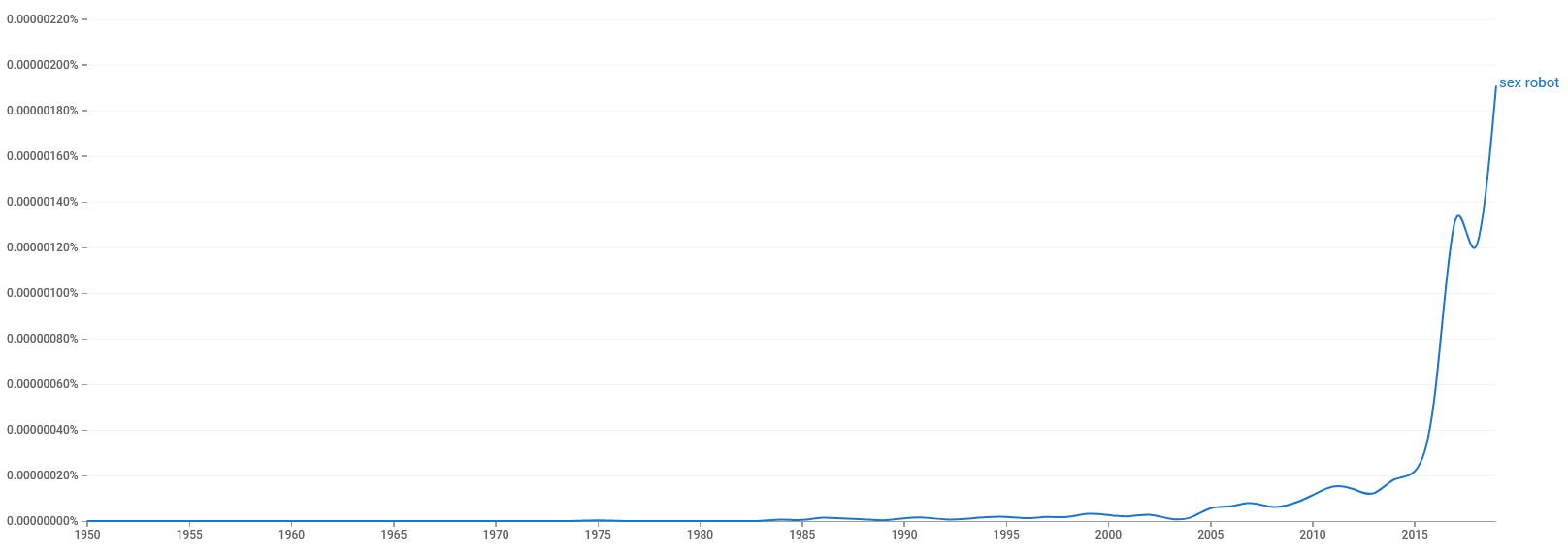
Comparing the increase from the spike of public attention on sexual robotic companions (see the Search Trend graph underneath) in 2018 to 2022 the increase in a relative number of peer-reviewed studies published that are concerned with “sex robots” has increased by 1,811%.

References
- Abrams, M., Williams, R. II., Tikkanen, R., Shah, T. & Pantell, M. (2020). Solutions from Around the World: Tackling Loneliness and Social Isolation During COVID-19. To the Point (blog), Commonwealth Fund.
- Archer, J. (2019). The reality and evolutionary significance of human psychological sex differences. Biological Review, 94, 1381–1415.
- Banks, J., & Van Ouytsel, J. (2020). Cybersex with human-and machine-cued partners: gratifications, shortcomings, and tensions.
- Baum, S., Barrett, A. & Yampolskiy, R. (2017). Modeling and interpreting expert disagreement about artificial intelligence. Informatica, 41, 419–427.
- Baum, S., Goertzel, B. & Goertzel, T. (2011). How long until human-level AI? Results from an expert assessment. Technological Forecasting and Social Change, 78, 185–195.
- Baumeister, R., Catanese, K. & Vohs, K. (2001). Is there a gender difference in strength of sex drive? Theoretical views, conceptual distinctions, and a review of relevant evidence. Personality and Social Psychology Review, 5, 242–273.
- Belk, R. (2022). Artificial emotions and love and sex doll service workers. Journal of Service Research, 10946705211063692.
- Bergen, J. (2020). Love(rs) in the making: Moral subjectivity in the face of sexbots. Journal of Behavioral Robotics, 11, 284–300.
- Björkas, R., & Larsson, M. (2021). Sex dolls in the Swedish media discourse: Intimacy, sexuality, and technology. Sexuality & Culture, 25(4), 1227-1248.
- Brandon, M. & Morgentaler, A. (2016). Male and female sexual dysfunction in a rapidly changing cultural environment: Addressing gender equality vs equivalence in the bedroom. Sexual Medicine Reviews, 4, 96–102.
- Brandon, M., Shlykova, N., & Morgentaler, A. (2022). Curiosity and other attitudes towards sex robots: Results of an online survey. Journal of Future Robot Life, 3(1), 3-16.
- Burghardt, J., Beutel, M., Hasenburg, A., Schmutzer, G. & Brahler (2020). Declining sexual activity and desire in women: Findings from representative German surveys 2005 and 2016. Archives of Sexual Behavior, 49, 919–925.
- Carroll, J., Busby, D., Willoughby, B. & Brown, C. (2017). The porn gap: Differences in men’s and women’s pornography patterns in couple relationships. Journal of Couple & Relationship Therapy, 16(2), 146–163.
- Ciambrone, D., Phua, V. & Avery, E. (2017). Gendered synthetic love: Real dolls and the construction of intimacy. International Review of Modern Sociology, 43, 59–78.
- Cubbins, L. & Tanfer, K. (2000). The influence of gender on sex: A study of men’s and women’s self-reported high-risk sex behavior. Archives of Sexual Behavior, 29, 229–257.
- Danaher, J. & McArthur, N. (Eds.) (2017). Robot Sex: Social and Ethical Implications. Cambridge MA: MIT Press.
- Dawson, S., Bannerman, B. & Lalumiere, M. (2014). Paraphilic interests: An examination of sex differences in a non-clinical sample. Sexual Abuse, 28, 20–45.
- De Vries, G. & Forger, N. (2015). Sex differences in the brain: A whole body perspective. Biology of Sex Differences, 6, 15.
- Devlin and D. Levy (Eds.), Love and Sex with Robots, Second International Conference, LSR 2016, London, UK, December 19–20, 2016, (pp. 72–83). London: Springer.
- DiTecco, D. D. B. A. (2020). New technology, same old stigma: An analysis of feminist discourses and sex work stigma in sex robot media (Doctoral dissertation, Carleton University).
- Doring, N. & Poschl, S. (2018). Sex toys, sex dolls, sex robots: Our under researched bed-fellows. Sexologies, 27, 133–138.
- Dubé, S., & Anctil, D. (2021). Foundations of erobotics. International journal of social robotics, 13(6), 1205-1233.
- Dubé, S., Santaguida, S., Anctil, D., Leshner, C., Vachon, D., & Johnson, A. (2021). Technology-based sexualities. Encyclopedia of Sexuality and Gender. Springer. doi, 10, 978-3.
- Döring, N. (2021). Sex dolls and sex robots. Encyclopedia of sexuality and gender. Newyork: Springer.
- Döring, N., & Poeschl, S. (2020). Experiences with diverse sex toys among German heterosexual adults: Findings from a national online survey. The Journal of Sex Research, 57(7), 885-896.
- Döring, N., & Pöschl, S. (2018). Sex toys, sex dolls, sex robots: Our under-researched bed-fellows. Sexologies, 27(3), e51-e55.
- Döring, N., Krämer, N., Mikhailova, V., Brand, M., Krüger, T. H., & Vowe, G. (2021). Sexual interaction in digital contexts and its implications for sexual health: a conceptual analysis. Frontiers in Psychology, 12.
- Edirisinghe, C. & Cheok, A.D. (2017). Robots and intimacies: A preliminary study of perceptions and intimacies with robots. In A.D. Cheok, K. Devlin and D. Levy (Eds.), Love and Sex with Robots, Second International Conference, LSR 2016, London, UK December 19–20, 2016, (pp. 137–147). London: Springer.
- Edirisinghe, C., Cheok, A.D. & Khougali, N. (2018). Perceptions and responsiveness to intimacy with robots: A user evaluation. In A.D. Cheok and D. Levy (Eds.), Love and Sex with Robots, Third International Conference, LSR 2017, London, UK, December 19–20, 2017, (pp. 138–157). Switzerland: Springer.
- Eichenberg, C., Khamis, M., & Hübner, L. (2019). The attitudes of therapists and physicians on the use of sex robots in sexual therapy: online survey and interview study. Journal of medical Internet research, 21(8), e13853.
- Evans, K. K. (2021). Sex robots and views from nowhere: A commentary on Jecker, Howard and Sparrow, and Wang. In Sex Robots (pp. 161-178). Springer, Cham.
- Fosch-Villaronga, E., & Poulsen, A. (2020). Sex care robots. Paladyn, Journal of Behavioral Robotics, 11(1), 1-18.
- Fosch-Villaronga, E., & Poulsen, A. (2021, March). Sex robots in care: Setting the stage for a discussion on the potential use of sexual robot technologies for persons with disabilities. In Companion of the 2021 ACM/IEEE International Conference on Human-Robot Interaction (pp. 1-9).
- Geher, G. & Gambacorta, D. (2010). Evolution is not relevant to sex differences in humans because I want it that way! Evidence for the politicization of human evolutionary psychology. EvoS Journal: The Journal of Evolutionary Studies Consortium, 2, 32–47.
- Giger, J. C., Piçarra, N., Alves‐Oliveira, P., Oliveira, R., & Arriaga, P. (2019). Humanization of robots: Is it really such a good idea?. Human Behavior and Emerging Technologies, 1(2), 111-123.
- Goertzel, B. (2015). Superintelligence: Fears, promises, and potential. Journal of Evolution and Technology., 24, 55–87.
- Gonzales-Gonzales, C., Gil-Iranzo, R. & Paderewsky, P. (2019). Sex with robots: Analyzing the gender and ethics approaches in design. In Interaccion ’19: Proceedings of the XX International Conference on Human Computer Interaction.
- González-González, C. S., Gil-Iranzo, R. M., & Paderewski-Rodríguez, P. (2020). Human–robot interaction and sexbots: A systematic literature review. Sensors, 21(1), 216.
- Hammond, N. & van Hooff, J. (2020). “This is me, this is what I am, I am a man”: The masculinities of men who pay for sex with women. The Journal of Sex Research, 57(5), 650–663.
- Hancock, E. (2020). Should society accept sex robots?. Paladyn, Journal of Behavioral Robotics, 11(1), 428-442.
- Harper, C. A., & Lievesley, R. (2020). Sex doll ownership: An agenda for research. Current Psychiatry Reports, 22(10), 1-8.
- Harper, C. A., Lievesley, R., & Wanless, K. (2021). Exploring the psychological characteristics of individuals who own sex dolls.
- Harper, C. A., Lievesley, R., & Wanless, K. (2022). Exploring the psychological characteristics and risk-related cognitions of individuals who own sex dolls. The Journal of Sex Research, 1-16.
- Harper, C. A., Lievesley, R., Woodward, E., WIlson, R., & Stubbs, L. (2022). Attitudes toward sex doll ownership: Scale development and preliminary validation.
- Herbenick, D., Reece, M., Schick, V., Sanders, S., Dodge, B. & Fortenberry, J. (2010). Sexual behavior in the United States: Results from a national probability sample of men and women age 14–94. Journal of Sexual Medicine, 7, 255–265.
- Hidaka, B. (2012). Depression as a disease of modernity: Explanations for increasing prevalence. Journal of Affective Disorders, 140(3), 205–214.
- Ibarra, F., Mehrad, M., Mauro, M., Godoy, M., Gruz, E., Nilforoushzadeh, M. & Russo, G. (2020). Impact of the COVID-19 pandemic on the sexual behavior of the population. The vision of the east and the west. International Brazilian Journal of Urology, 46, 1677–6119.
- Johnson, D. G., & Verdicchio, M. (2020). Constructing the meaning of humanoid sex robots. International Journal of Social Robotics, 12(2), 415-424.
- Koverola, M., Dronsinou, M., Palomaki, J., Halonen, J., Kunnari, A., Repo, M., Lehtonen, N. & Laakasuo, M. (2020). Moral psychology of sex robots: An experimental study – how pathogen disgust is associated with interhuman sex but not interandroid sex. Journal of Behavioral Robotics, 11, 233–249.
- Kunst, J., Bailey, A., Prendergast, C. & Gundersen, A. (2019). Sexism, rape myths and feminist identification explain gender differences in attitudes toward the #metoo social media campaign in two countries. Media Psychology, 22, 818–843. doi:10.1080/15213269.2018.1532300.
- Levy, D. (2007). Love & Sex with Robots. New York: HarperCollins.
- Liberati, N. (2020). Making out with the world and valuing relationships with humans. Journal of Behavioral Robotics, 11, 140–146. doi:10.1515/pjbr-2020-0010.
- Lievesley, R., Reynolds, R., & Harper, C. A. (2022). The ‘perfect’partner: Understanding the lived experiences of sex doll owners.
- Liu, M.-Y., Li, N., Li, W. & Khan, H. (2017). Association between psychosocial stress and hypertension: A systematic review and meta-analysis. Neurological Research, 39, 573–580.
- Liu, Q., He, H., Yang, J., Feng, X., Zhao, F. & Luy, J. (2020). Changes in the global burden of depression from 1990 to 2017: Findings from the Global Burden of Disease study. Journal of Psychiatric Research, 126, 134–140.
- Locatelli, C. (2022). Rethinking ‘Sex Robots’: Gender, Desire, and Embodiment in Posthuman Sextech. Journal of Digital Social Research, 4(3), 10-33.
- Ma, J., Tojib, D., & Tsarenko, Y. (2022). Sex Robots: Are We Ready for Them? An Exploration of the Psychological Mechanisms Underlying People’s Receptiveness of Sex Robots. Journal of Business Ethics, 1-17.
- McBurney, D., Zapp, D. & Streeter, S. (2005). Preferred number of sex partners: Tails of distributions and tales of mating systems. Evolution and Human Behavior, 26, 271–278.
- McKeever, N. (2022). Online Dating and Love Robots: How Technology May Undermine Valuable Features of Romantic Love. In Philosophy of Love in the Past, Present, and Future (pp. 240-256). Routledge.
- McNulty, J., Maxwell, J., Maltzer, A. & Baumeister, R. (2019). Sex-differentiated changes in sexual desire predict marital dissatisfaction. Archives of Sexual Behavior, 48, 2473–2481.
- Morandini, J., Veldre, A., Holcombe, A., Hsuk, K., Lykins, A., Baily, J. & Dar-Nimrod, I. (2019). Visual attention to sexual stimuli in mostly heterosexuals. Archives of Sexual Behavior, 48(5), 1371–1385.
- Muller, V. & Bostrom, N. (2016). Future progress in artificial intelligence: A survey of expert opinion. In V.C. Muller (Ed.), Fundamental Issues of Artificial Intelligence, Switzerland: Springer.
- Nyholm, S., Danaher, J., & Earp, B. D. (2021). The technological future of love. In Philosophy of Love in the Past, Present, and Future (pp. 224-239). Routledge.
- Oleksy, T., & Wnuk, A. (2021). Do women perceive sex robots as threatening? The role of political views and presenting the robot as a female-vs male-friendly product. Computers in Human Behavior, 117, 106664.
- Peterson, J. & Hyde, J. (2010). A meta-analytic review of research on gender differences in sexuality, 1993–2007. Psychological Bulletin, 136, 21–38.
- Prokop, P. & Jancovicova, M. (2013). Disgust sensitivity and gender differences: An initial test of the parental investment hypothesis. Problems of psychology in the 21st. Century, 7, 40–48.
- Richards, R., Coss, C. & Quinn, J. (2017). Exploration of relationship factors and the likelihood of a sexual robotic experience. In A.D. Cheok, K. Devlin and D. Levy (Eds.), Love and Sex with Robots, Second International Conference, LSR 2016, London, UK, December 19–20, 2016, (pp. 97–103). London: Springer.
- Richardson, K. (2016). The asymmetrical “relationship”: Parallels between prostitution and the development of sex robots. ACM SIGCAS Computers and Society, 45(3), 290–293.
- Richardson, K. (2019). The human relationship in the ethics of robotics: A call to Martin Buber’s I and Thou. AI & Society, 34(1), 75–82.
- Rigotti, C. (2020). How to apply Asimov’s first law to sex robots. Paladyn, Journal of Behavioral Robotics, 11(1), 161-170.
- Rothstein, N. J., Connolly, D. H., de Visser, E. J., & Phillips, E. (2021, March). Perceptions of Infidelity with Sex Robots. In Proceedings of the 2021 ACM/IEEE International Conference on Human-Robot Interaction (pp. 129-139).
- Rousi, R. (2021, July). Ethical stance and evolving technosexual culture–a case for human-computer interaction. In International Conference on Human-Computer Interaction (pp. 295-310). Springer, Cham.
- Scheutz, M. & Arnold, T. (2016). Are we ready for sex robots? In Proceedings of the 11th ACM/IEEE International Conference on Human Robot Interaction (pp. 351–358).
- Scheutz, M. & Arnold, T. (2018). Intimacy, bonding, and sex robots: Examining empirical results and exploring ethical ramifications. In J. Danaher and N. McArthur (Eds.), Robot Sex: Social and Ethical Implications (pp. 247–260). Cambridge, MA: The MIT Press.
- Schmitt, D., Shackelford, T., Duntley, J., Tooke, W. & Buss, D. (2001). The desire for sexual variety as a key to understanding basic human mating strategies. Personal Relationships, 8, 425–455.
- Smith, A., Lyons, A., Ferris, J., Richters, J., Pitts, M., Shelly, J. & Simpson, J. (2011). Sexual and relationship satisfaction among heterosexual men and women: The importance of desired frequency of sex. Journal of Sex and Marital Therapy, 37, 104–115.
- Sotala, K. & Yampolskiy, R. (2015). Responses to catastrophic AGI risk: A survey. Physica Scripta, 90(1), 018001.
- Szczuka, J. & Kramer, N. (2017a). Influences on the intention to buy a sex robot: An empirical study on influences of personality traits and personal characteristics on the intention to buy a sex robot. In A.D. Cheok, K.
- Szczuka, J. & Kramer, N. (2017b). Not only the lonely: How men explicitly and implicitly evaluate the attractiveness of sex robots in comparison to the attractiveness of women, and personal characteristics influencing this evaluation. Multimodal Technologies and Interaction, 1, 3.
- Szczuka, J. & Kramer, N. (2018). Jealousy 4.0? An empirical study on jealousy-related discomfort of women evoked by other women and gynoid robots. Journal of Behavioral Robotics, 9, 323–336.
- Torales, J., O’Higgins, M., Castaldelli-Maia, J. & Ventiglio, A. (2020). The outbreak of COVID-19 coronovirus and its impact on global mental health. International Journal of Social Psychiatry, 66, 317–320.
- Troiano, G. M., Wood, M., & Harteveld, C. (2020, April). ” And This, Kids, Is How I Met Your Mother”: Consumerist, Mundane, and Uncanny Futures with Sex Robots. In Proceedings of the 2020 CHI Conference on Human Factors in Computing Systems (pp. 1-17).
- Ueda, P., Mercer, C., Ghaznavi, C. & Herbenick, D. (2020). Trends in frequency of sexual activity and number of sex partners among adults ages 18 to 44 years in the US, 2000–2018. JAMA Network Open, 3, e203833.
- Viik, T. (2020). Falling in love with robots: A phenomenological study of experiencing technological alterities. Journal of Behavioral Robotics, 11, 52–65.
- Wu, Y., Ku, L. & Zaroff, C. (2016). Sexual arousal and sexual fantasy: The influence of gender, and the measurement of antecedents and emotional consequences in Macau and the United States. International Journal of Sexual Health, 28, 55–69.
